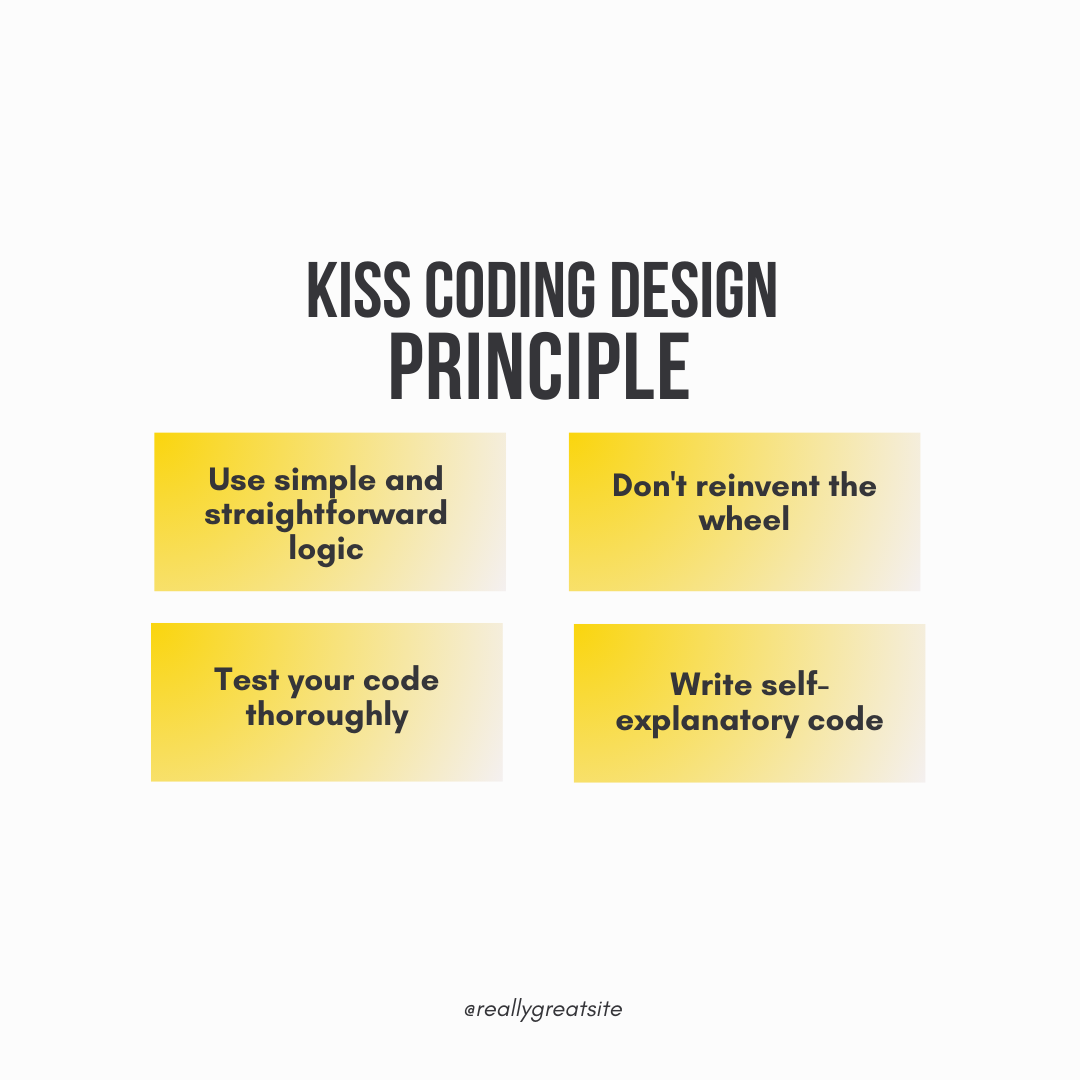“Keep It Simple, Stupid” (KISS) is a design principle that suggests that systems should be kept as simple as possible, avoiding unnecessary complexity. In the context of programming, this means that code should be written as simply and clearly as possible, without unnecessary complexity or convoluted logic. The goal is to make the code easy to read, maintain, and debug.
Here are some ways to apply the KISS principle in your code:
- Use simple and straightforward logic:
Avoid using complicated logic and try to keep your code as straightforward as possible. it’s important to use simple and straightforward logic to make your code easy to understand and maintain. One way to achieve this is by avoiding overly complicated control structures, such as nested loops and conditions. Instead, aim to break down complex tasks into smaller, more manageable pieces, and use simple control structures that are easy to follow. Additionally, using clear and descriptive variable names can help make your code more self-explanatory, reducing the need for comments and making it easier for other developers to read and understand your code. By keeping your logic simple and straightforward, you can reduce the risk of errors and make it easier to debug and maintain your code over time.
Here are some tips for using simple and straightforward logic in your coding:
- Plan out your code before you start writing it. One of the biggest mistakes that new programmers make is diving right into writing code without first thinking through what they want to accomplish. Taking the time to plan out your code will help you identify any potential issues before you start writing and will make the overall process much smoother.
- Break complex problems down into smaller, more manageable parts. When you’re working on a large coding project, it can be easy to get overwhelmed by the complexity of the problem you’re trying to solve. To make things easier, break the problem down into smaller, more manageable parts, and focus on solving each part individually.
- Keep your code simple and readable. When you’re writing code, it’s important to remember that other people will be reading and working with your code in the future. To make things easier for them (and for yourself), keep your code simple, readable, and well-organized.
- Use clear and concise variable names. One of the most common mistakes that new programmers make is using variable names that are unclear or overly complicated. To make your code easier to read and understand, use clear and concise variable names that accurately describe what each variable represents.
- Test your code thoroughly. Once you’ve written your code, it’s important to test it thoroughly to ensure that it works as expected. This will help you identify any issues before your code is released into the wild and will save you a lot of headache in the long run.
- Write self-explanatory code:
When writing code, it’s important to make it as easy to understand as possible. One way to achieve this is by writing self-explanatory code, which can be understood without the need for additional comments or explanations. This can be achieved by using clear and descriptive variable names that accurately reflect the purpose of the variable, as well as by using consistent naming conventions throughout your code. Additionally, structuring your code in a logical and easy-to-follow manner can also help make it more self-explanatory. When other developers can understand your code without needing to ask questions or consult additional documentation, it can save time and reduce the likelihood of errors being introduced due to misunderstandings.
Here are some tips for writing self-explanatory code:
- Use descriptive variable and function names. The names you choose for your variables and functions should accurately reflect what they do. Avoid generic names like “temp” or “foo” and instead use descriptive names like “customer_name” or “calculate_total”.
- Keep your code simple and focused. Avoid writing overly complex code that tries to accomplish too many things at once. Instead, break your code down into smaller, more focused functions that do one thing and do it well.
- Use consistent formatting and indentation. Consistency is key when it comes to writing self-explanatory code. Use the same formatting and indentation throughout your code to make it easier to read and understand.
- Comment your code sparingly. While comments can be helpful, they can also be overused and lead to cluttered code. Only add comments where necessary to explain complex or unintuitive parts of your code.
- Write code with future developers in mind. Remember that other developers may be working with your code in the future. Write code that is easy for them to understand, and avoid using obscure language or shortcuts that may be unfamiliar to them.
- Refactor your code regularly. As your codebase grows, it’s important to regularly refactor your code to ensure that it remains clean, concise, and easy to understand.
- Don’t reinvent the wheel:
In programming, it’s important to avoid reinventing the wheel, or creating new solutions to problems that have already been solved by existing code. Rather than starting from scratch, you can save time and effort by leveraging existing libraries, frameworks, and tools that have already been developed and tested. This not only saves you the time and effort of creating new code, but it can also ensure that you’re using code that has been thoroughly tested and optimized for performance. Additionally, by using widely adopted libraries and frameworks, you can ensure that your code will be easier for other developers to understand and maintain, since they will likely already be familiar with these common solutions. Ultimately, avoiding the reinvention of the wheel can help you write more efficient, reliable, and maintainable code.
Tips on how not to reinvent the wheel in coding
- Do your research: Before you start coding, take the time to research the available libraries, frameworks, and tools. Look for ones that are well-documented, have a strong user community, and meet your specific needs.
- Use existing code: When you’re coding, use existing code whenever possible. This can include things like open-source libraries or code snippets that you find online. Just be sure to properly attribute the original author and ensure that the code is licensed appropriately.
- Follow best practices: When you use existing libraries and frameworks, make sure you’re following best practices and industry standards. This can help you avoid common mistakes and ensure that your code is reliable and maintainable.
- Stay up-to-date: Keep up-to-date with the latest versions of the libraries, frameworks, and tools you’re using. This can help you take advantage of new features and improvements, and ensure that your code remains secure and stable.
- Contribute back to the community: If you find a library, framework, or tool that you’re using frequently, consider contributing back to the community. This can include things like submitting bug reports, writing documentation, or contributing code changes. This can help improve the overall quality of the tool and ensure that it continues to be useful for future projects.
- Know when to build your own: There may be times when existing libraries, frameworks, and tools don’t meet your specific needs. In these cases, it may be necessary to build your own solution. However, before you start coding, make sure you’ve done your research and determined that there are no existing solutions that can meet your needs.
- Test your code thoroughly:
Thoroughly testing your code is a critical part of the development process. Automated testing tools can help you catch bugs and other issues early in the development process, allowing you to address them before they become major problems. By testing your code thoroughly, you can ensure that it is reliable and robust, and that it works as intended in a variety of scenarios. Testing can also help you identify performance bottlenecks and other issues that could impact the user experience. Ideally, you should test your code at every stage of the development process, from unit testing during development to acceptance testing before deployment. This can help you catch issues early, and ensure that your code meets the necessary requirements and standards. Ultimately, thorough testing can help you deliver high-quality, reliable software that meets the needs of your users.
Tips on How to test code
- Create a testing plan: Before you start writing code, create a plan for how you will test it. This should include a list of test cases and expected outcomes. A good testing plan will help you stay organized and ensure that you test all aspects of your code.
- Test early and often: Don’t wait until the end of your project to start testing. Instead, test your code early and often. This will help you catch bugs and errors early in the development process, making them easier to fix.
- Use automated testing tools: Automated testing tools can help you test your code quickly and efficiently. There are many tools available, such as unit testing frameworks, integration testing tools, and performance testing tools. Choose the ones that best meet your needs and use them regularly.
- Test all possible scenarios: Make sure you test your code in all possible scenarios. This includes testing edge cases, unexpected inputs, and error conditions. By testing all scenarios, you can ensure that your code is robust and can handle any situation that may arise.
- Use code coverage tools: Code coverage tools can help you identify areas of your code that have not been tested. These tools measure the percentage of code that has been executed during testing and can help you identify areas that may need additional testing.
- Test on multiple platforms: Make sure you test your code on multiple platforms, such as different operating systems, web browsers, and mobile devices. This can help you identify platform-specific bugs and ensure that your code works correctly on all platforms.
- Involve others in testing: Don’t rely solely on your own testing efforts. Involve others in testing your code, such as colleagues, beta testers, or end-users. This can provide valuable feedback and help you identify issues that you may have overlooked.
By sticking to the KISS principle, you can write code that is easy to read, maintain, and debug. This can save you time and effort, as well as ensure that your code is reliable and robust.







